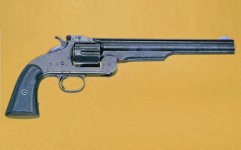I am working on a massacre site that happened in 1871... the two weapons were a Spencer rifle and a S&W pistol...the information I have found just says a S&W top-break revolver...but not the caliber....in 1871 would the bullet be a .32 or a .38 ? which would be most common in the west ? Ideas?
As part of my research I bought a Spencer and a Winchester of that age...and fired both to see why the Spencer was chosen...it turned out easy...both fired about the same speed but the Spencer reloaded much, much faster using extra tubes...
I also assume that is why the S&W was also chosen over the Colt or any other.
Once the weather gets better I am returning with a metal detector to find and chart the bullets on the site... This was a well planned out massacre where 30 indians were killed...I am only guessing but to kill 30 you had to fire over 200 bullets
Thanks
Joel
As part of my research I bought a Spencer and a Winchester of that age...and fired both to see why the Spencer was chosen...it turned out easy...both fired about the same speed but the Spencer reloaded much, much faster using extra tubes...
I also assume that is why the S&W was also chosen over the Colt or any other.
Once the weather gets better I am returning with a metal detector to find and chart the bullets on the site... This was a well planned out massacre where 30 indians were killed...I am only guessing but to kill 30 you had to fire over 200 bullets
Thanks
Joel



